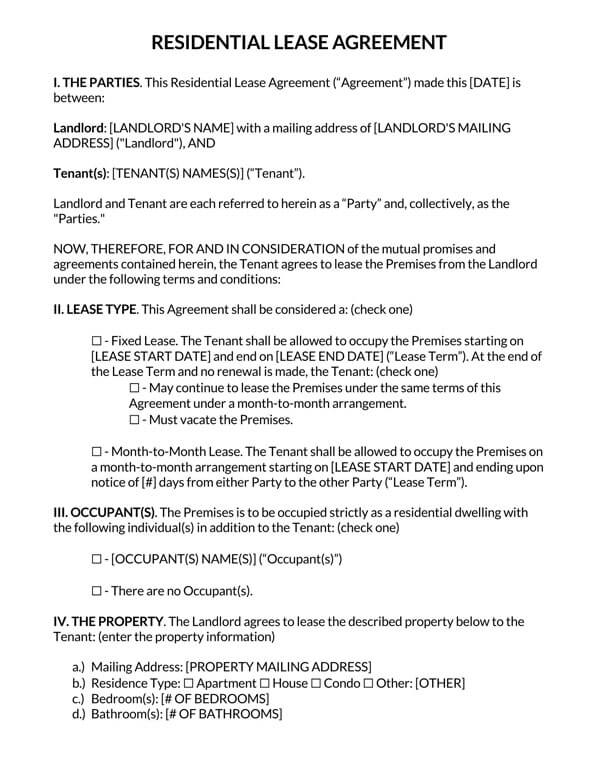A Lease Agreement is a contract that legally binds the landlord and his or her tenant(s) by outlining all the terms and conditions for renting a property.
It becomes effective once both parties have signed and remain effective throughout the rental term until the expiration date (i.e., last date of tenancy).
The landlord and tenant’s contractual leasing rights and obligations, as well as the ramifications of violating the set out terms, are outlined in the lease agreement – the landlord is therefore protected in case of any disputes or claims. Additionally, a lease agreement is a reference tool for determining liability for various circumstances during a tenancy.
For example:
If certain property taxes are unpaid for a given year, the lease agreement can be used as a basis for confirming which party was responsible for covering the taxes as agreed.
Lease agreements should be in writing; verbal lease agreements are difficult to legally enforce in a court of law. It is therefore recommended that landlords have a lease in place when renting out properties to ensure that non-compliant tenants are held accountable.
It is worth noting that state laws govern residential property leasing. Therefore, having a lease agreement in place is one way of fulfilling state laws leasing requirements. Also, through it, other leasing state guidelines and landlord-imposed house policies are set forth for tenants.
For example:
Most landlords use a lease agreement to ask for a security deposit.
Lease agreements are used when renting out different residential properties such as:
- Apartments
- Condominiums
- Townhouses
- Duplexes
The residential lease agreement is also known by other names. These are:
- Lease Agreement
- Rental Agreement
- Rental Lease Agreement
- Rental Contract
- Apartment Lease
- House Rental Agreement
- Lease Form
Types of Lease Agreements
There are different types of lease agreements depending on the scenario which it is being applied.
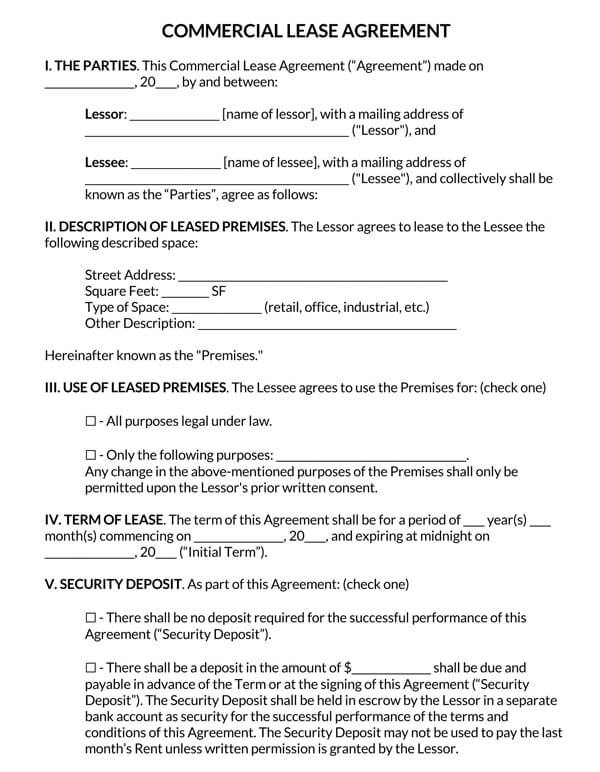
Commercial Lease Agreement
Commercial agreements are agreements used to rent out non-residential buildings, industrial spaces, offices, and retail properties.
Download: Microsoft Word (.docx)
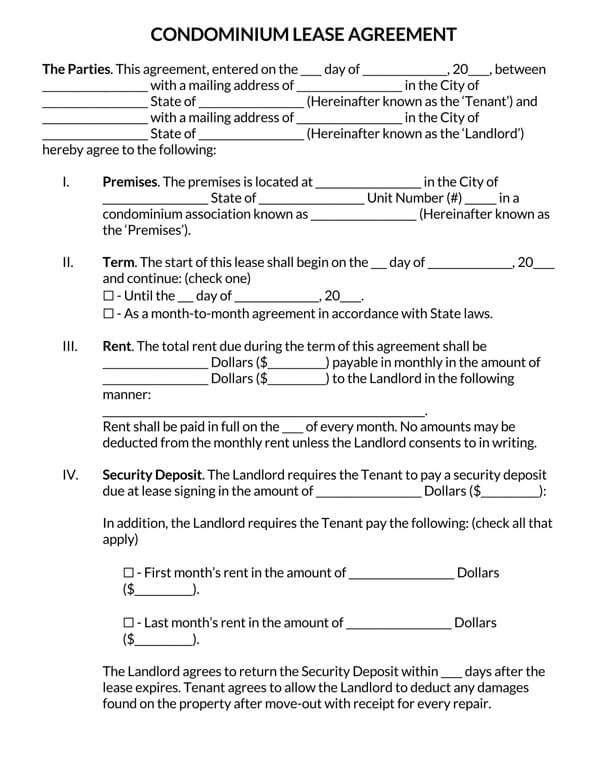
Condominium Lease Agreement Template
A condominium lease agreement is used to rent condominiums (units in a complex owned by different individuals). It can be used where a tenant intends to rent with an option to purchase.
Download: Microsoft Word (.docx)
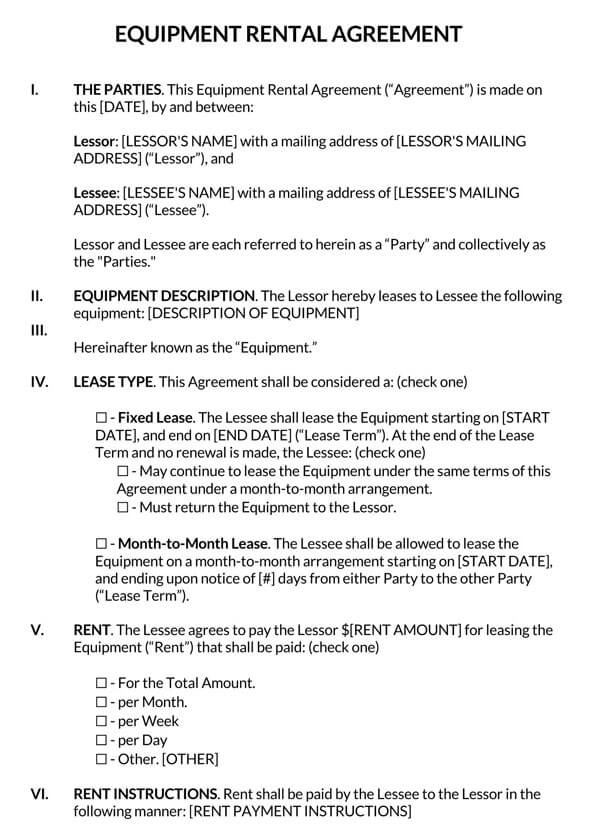
Equipment Lease Agreement
Equipment lease agreements are agreements used for renting out equipment such as machinery, tools, etc.
Download: Microsoft Word (.docx)
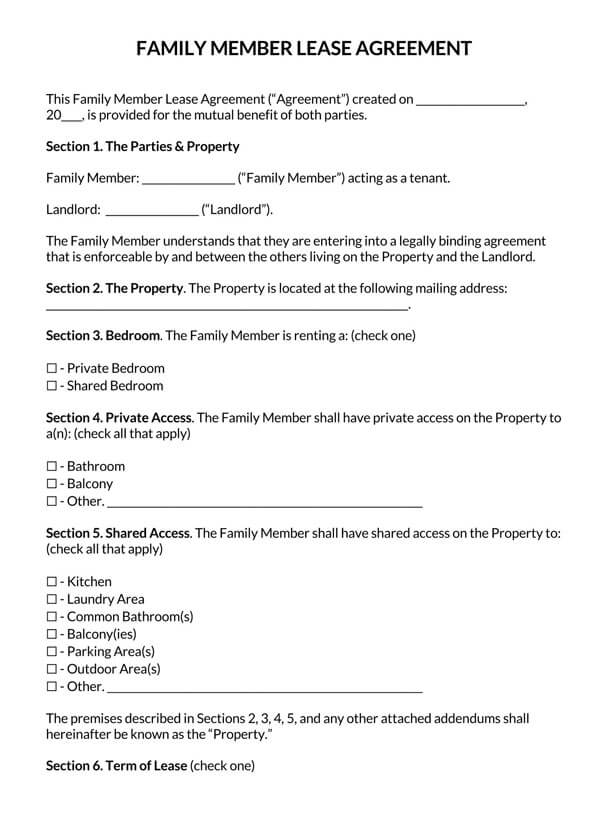
Family Member Lease Agreement
A family member lease agreement allows other family members, i.e., son or a spouse, to pay the rent for the leased property.
Download: Microsoft Word (.docx)
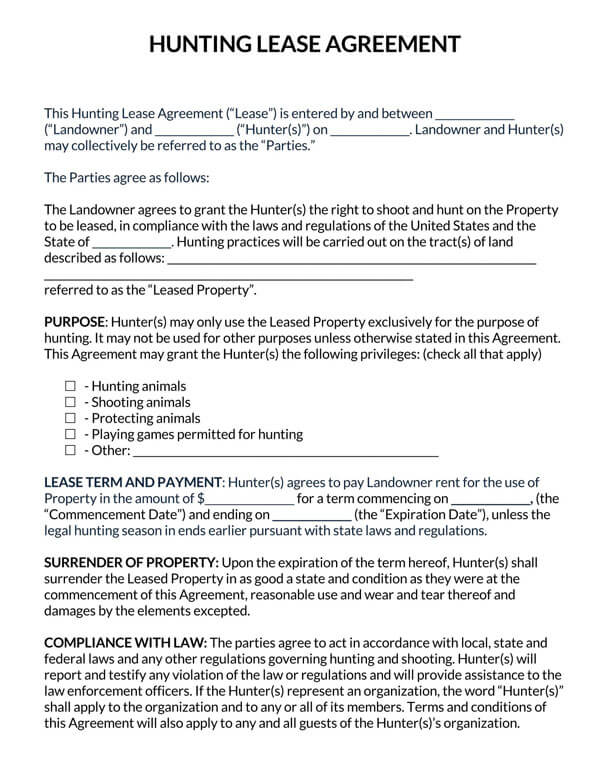
Hunting Lease Agreement Template
A hunting lease agreement is used by individuals seeking permission to hunt on privately owned property.
Download: Microsoft Word (.docx)
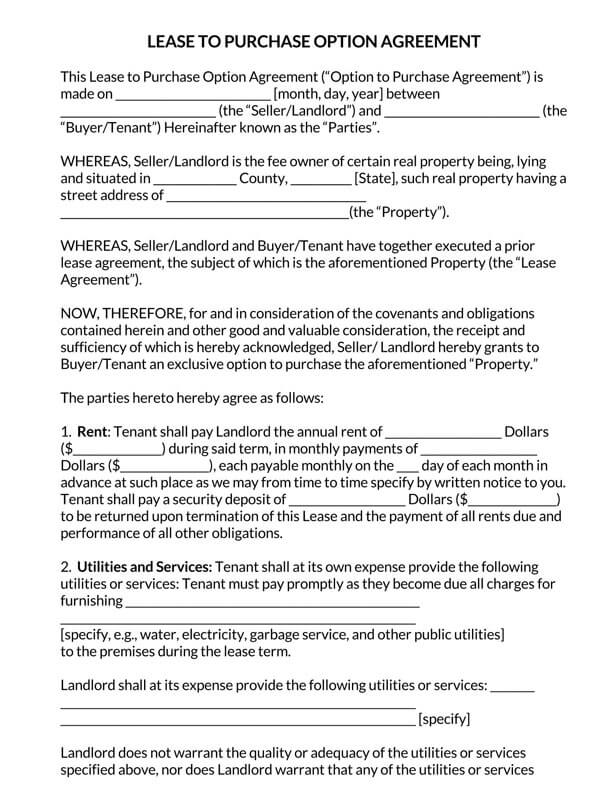
Lease to Own Option to Purchase Agreement
Landlords who are renting out a residential property to tenants with an option to sell the same property to the same tenant use a lease-purchase agreement. Rental payments plus add-ons are used to cover the purchase price.
Download: Microsoft Word (.docx)
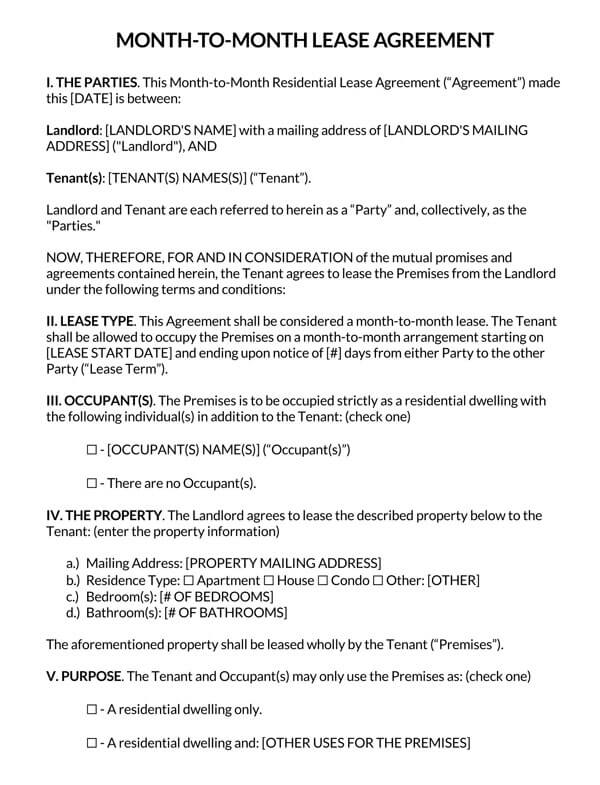
Month to Month Lease Agreement Template
A month-to-month lease is used by landlords who do not wish to rent out their property for a fixed term; therefore, the lease arrangement is renewed every month and can be altered with a thirty-day notice.
Download: Microsoft Word (.docx)
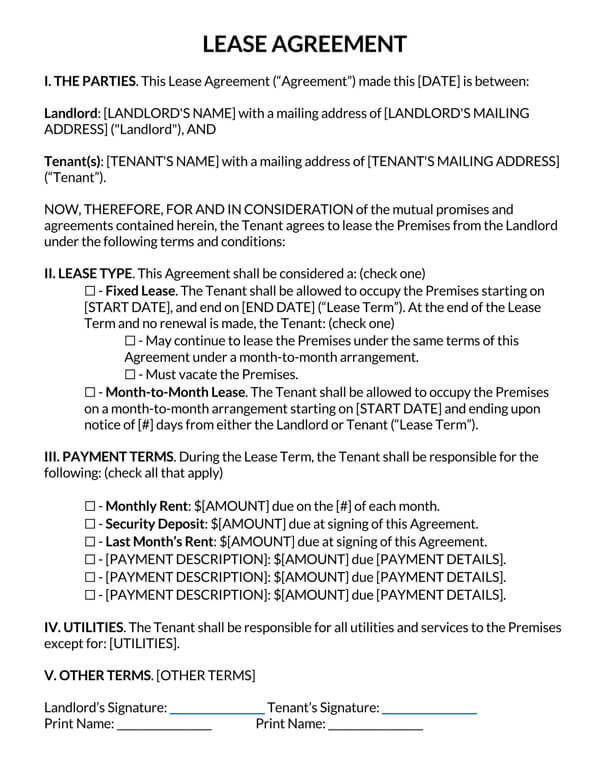
One -1 Page Residential Lease Agreement
One-page lease agreements are simple lease agreements used for fixed-term tenancy such as 12 months.
Download: Microsoft Word (.docx)
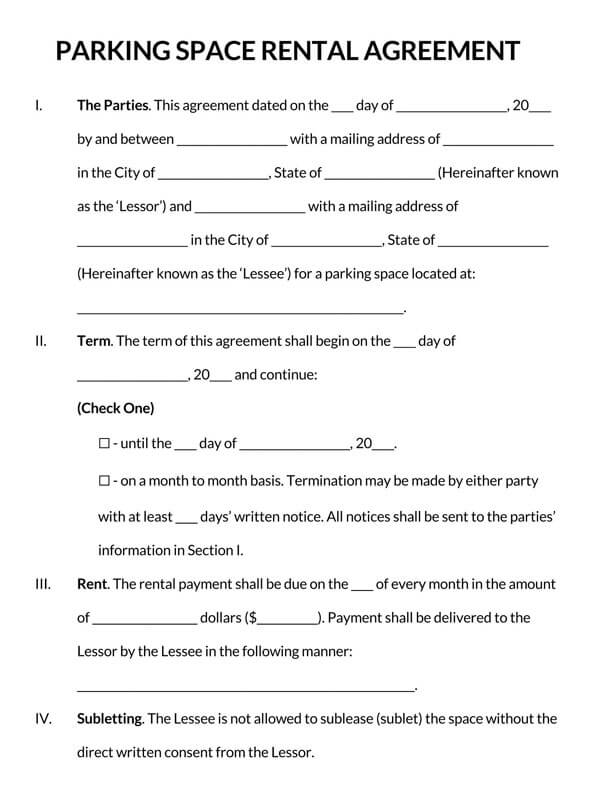
Parking Space Rental Agreement Template
A parking space lease agreement is used to rent out a privately owned parking space to another party for use for their vehicle, motorcycle, etc.
Download: Microsoft Word (.docx)
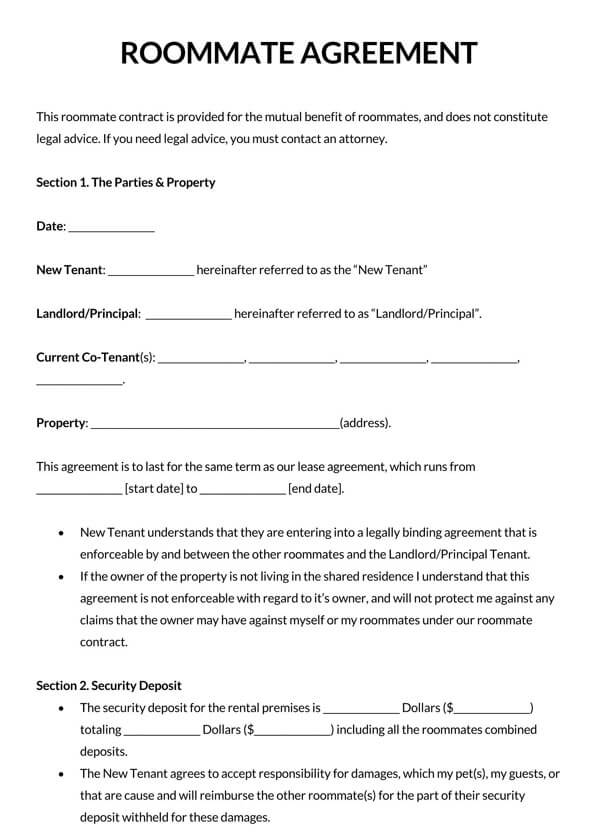
Roommate Agreement Template
A room rental agreement is used when seeking a roommate with whom one is to share the residential rental obligation
Download: Microsoft Word (.docx)
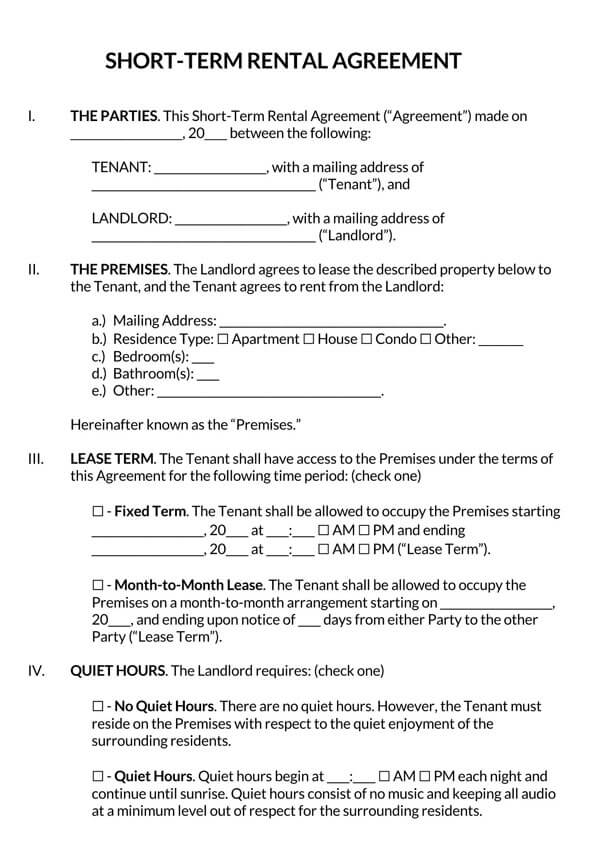
Short Term Vacation Lease Agreement
A vacation lease agreement is one that property owners use to rent out their property for a few days, such as a vacation. It is also referred to as a short-term lease agreement.
Download: Microsoft Word (.docx)
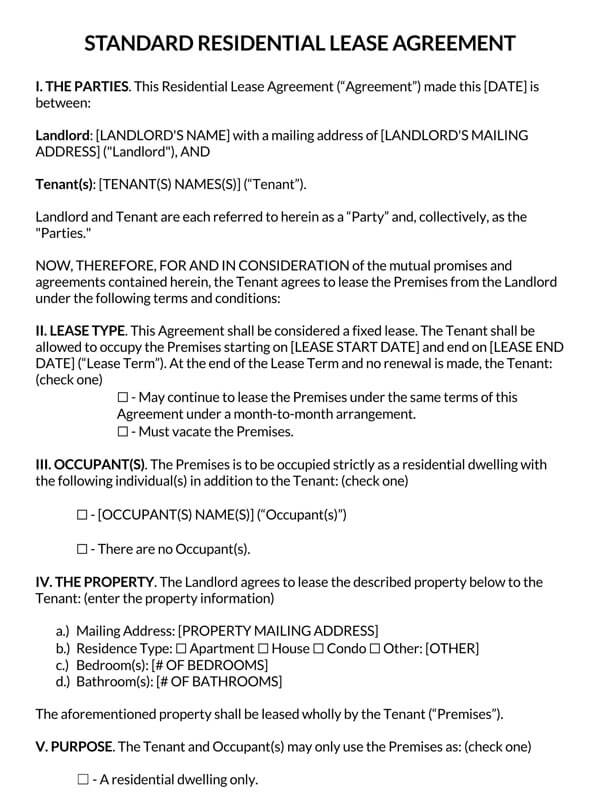
Standard Residential Lease Agreement Form
A standard residential lease agreement is used to lease property for one year or any fixed lease term.
Download: Microsoft Word (.docx)
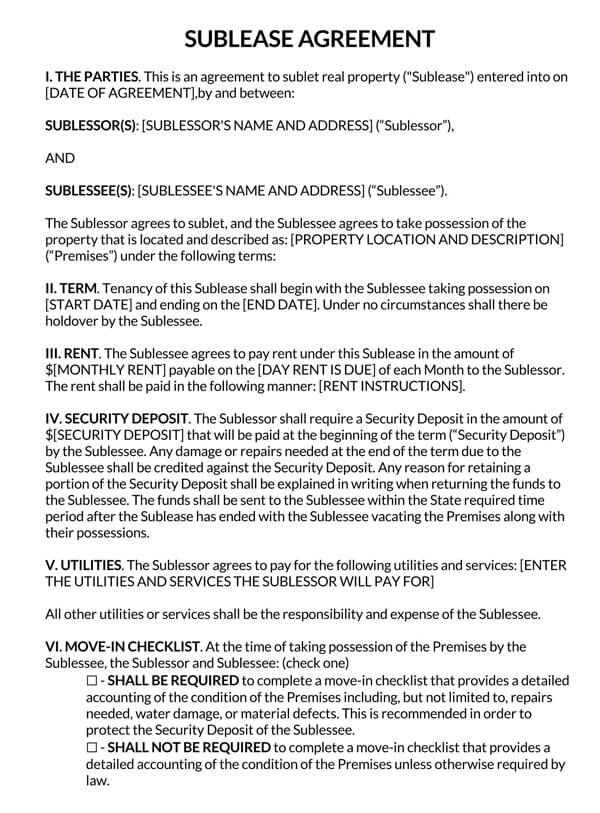
Sublease Agreement
A sublease residential lease agreement is one used by tenants to rent out the rented property to another party.
Download: Microsoft Word (.docx)
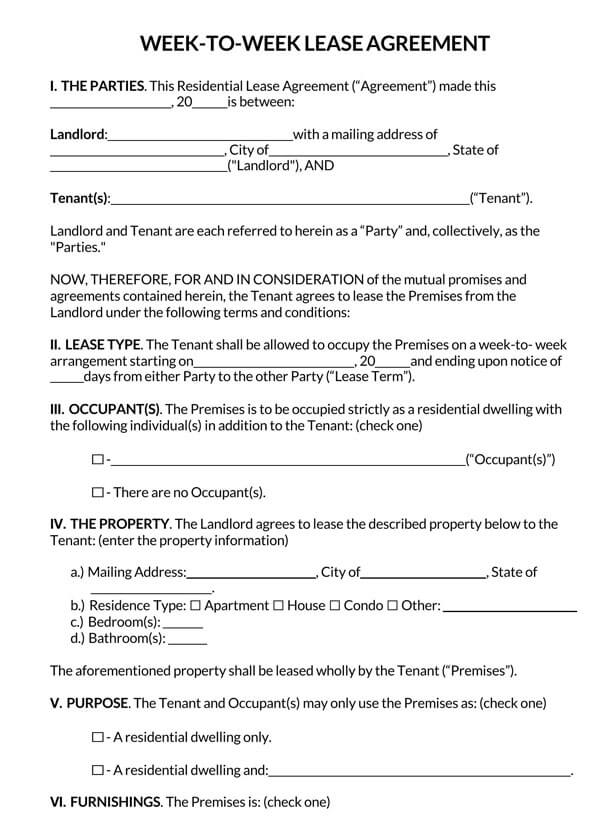
Week to Week Lease Agreement Form
A weekly lease agreement is used by landlords renting their property on a weekly basis such that rent is paid every week.
Download: Microsoft Word (.docx)
Who Needs a Lease Agreement and Why
Whenever renting out any type of residential property, landlords are always advised to use a lease agreement. The following individuals are typical users of a lease agreement.
- Landlords, property managers, tenant placement service providers, and real estate agencies that rent out residential property
- Residential homeowners renting out part or all of the property
- Individuals renting their homes to family or friends
A lease agreement benefits the parties mentioned above as follows:
- Protects residential property owners from financial pitfalls associated with leasing
- Highlights pertinent information relating to the lease (tenant details, term of residency, all fees)
- Ensures the property is maintained properly
- Smoothens the admission of future tenants by allowing them to review the lease before
How to Write a Residential Lease
A lease agreement, once drafted, should be a communication of what each signatory expects from the other. Having clearly defined roles and responsibilities ensures tenancy is actualized dispute-free. For the lease agreement to serve its intended purposes, it ought to touch on all the relevant details as well as additional terms that might raise concerns during the lease term. Below is a procedural guide of how landlords can craft an effective residential lease agreement while including all the necessary components.
Date
Firstly, a lease agreement must be dated. So, indicate the date when it was written, which usually marks the first day the agreement becomes effective.
Introduce the parties
Secondly, the parties bound by the residential lease agreement should be identified. The landlord and the tenant must provide their names, mailing addresses, and states of residence. The information provided here should be as given in official documents.
Define the term of the lease
Thirdly, declare the length of the lease term. This is the period the property is to be rented to the specific tenant. Clearly define the lease term. The following types of lease terms are common.
- Fixed-term lease – A fixed lease term has a predetermined end date. Typically, this term is one year but can be if both parties have agreed.
- Month-to-month lease/ Lease renewal – A month-to-month lease term does not have a set end date; it is renewed after a certain period (usually every month).
Occupants’ details
Tenants can sometimes be renting the place together with other individuals. If this is the case, declare that the tenant will be living with other individuals in the lease. Then provide details of the occupants such as names and the number of the occupants. One can even include the relationship, for example, children, siblings, or friends.
Describe the premises
Then proceed to state the residential property that will be leased. Information provided in this section should specify the property such that it can be used to identify it. Provide the following details.
- Address – Indicating the mailing address aids in declaring where the property is located. The mailing address must show the street/avenue city and state where the property is located.
- Type of residence – Declare the type of residential property being leased, for example, apartment.
- A description of the property – Indicate the number of bedrooms and bathrooms that the property has.
Purpose
The lease agreement must then show how the property will be utilized by the tenant (purpose). For example, a residential property can be used as a residential dwelling only or as a residential dwelling and any other activity, like a business activity.
Furnishings
The next section of the residential lease agreement addresses the furnishing arrangement between the landlord and the tenant. Sometimes residential properties, especially short-term rental properties, must be furnished with essential items like beds, couches, and desks. If this is the case, list every furnishing in the space. This section can be used as a checklist when the tenant moves out to confirm if every item was left in good condition. Waterbeds – Liquid-filled furnishings are known to have negative impacts on a property in the long run. If such furnishings are prohibited within the premises, declare it in this section of the lease.
Appliances
State any appliances the tenant is expected to find on the premises when moving in. Appliances include ovens, microwaves, refrigerators, laundry machines, etc.
Set how much rent is owed
Afterward, state how much money the tenant is expected to pay as rent for occupying the premises. Include the following rent details.
- Rent amount – Indicate the exact amount is to be paid as rent. Use appropriate monetary units such as dollars ($).
- Due date – The due date is the date before which the tenant is expected to have paid rent every month or as agreed.
- Payment instructions – Outline any instructions the have to be followed regarding payments.
Note: How much landlords can charge as rent is governed by local rent control laws. Consult these laws to ensure the set amount is compliant with the regulations.
NSF checks
Landlords should indicate the penalties applicable to tenants who issue Non-Sufficient Funds checks. NSF checks are occasionally witnessed when leasing property; it is best to prepare if such a case occurs. Indicate the exact amount to be penalized.
Late fee
The next component of the lease agreement is the late fees imposed for late payment of rent. Late payment of rent is not uncommon in leasing property. Therefore, declare the criteria used to determine that a tenant is late on a payment (days after due date) and state the amount of money they shall be penalized as late fees.
First month’s rent
State when the first month’s rent is due. Habitually, two options are available for consideration – either the tenant can pay on the date of lease agreement signing or on the first day of the lease term (day of moving on).
Prepayment of rent
Indicate if the tenant is expected to pay rent in advance or not. Prepayment sometimes is necessary, especially with short-term (vacation) residential lease agreements. Indicate the amount to be paid in advance and the lease term it is meant to cover.
Proration period
State whether the tenant will be moving in before the first day of the lease term referred to as the proration period. State the amount of rent they should pay for this period. Calculate the proration rent amount by dividing the monthly rent by the number of days and multiply by the number of days prior to the start of the lease that the tenant will be taking occupancy of the premises.
Assign a security deposit amount
A security deposit is the amount landlords are legally allowed to ask tenants to pay as insurance for any damages that might occur on the property. State the exact amount and in the appropriate monetary unit. Ordinarily, it is equal to one month’s rent.
Move-in inspection
A move-in inspection is an inspection carried out before or shortly after a tenant moves in to check for any damages to the property. Indicate whether a move-in inspection will be done or not.
Sale of property
Sometimes as a landlord, one may have to sell the residential property before the lease term ends. The residential lease agreements should state if the landlord is afforded that right and under which conditions, usually a notice. Indicate the number of days of the notice before the sale of the property.
Utilities
Utilities such as water, air conditioning, etc., are a necessity when it comes to rental properties. However, utilities come at a cost. Therefore, the residential lease agreement should declare the utilities available within the property and who’s obligated to cover their costs.
Early termination
It is common for tenants to want to terminate the lease agreement due to unavoidable reasons. The residential lease agreement should declare if the tenant is accorded that right or not. If yes, the applicable terms must be outlined, such as the associated early termination fee and the number of days before termination they should issue a notice.
Smoking policy
Most premises will have a smoking policy in place. Indicate if tenants are allowed to smoke or not on the premises. If they are allowed, applicable conditions should be stated.
Pets and pet fee
As a landlord, one can permit or deny pets within the premises. State if there is a pet policy within the premises. If keeping pets is allowed on the condition that a pet fee is paid, indicate the amount charged as a pet fee and the applicable conditions such as the number of pets, type, and weight of the pets.
Parking and parking fee
For most tenants, parking space is a consideration when renting residential property. As a landlord, indicate whether parking space will be available or not. If there is a parking fee applicable, declare it and state the amount and whether it is charged per individual/house or per vehicle.
Notices
Notices are essential documents for communication between landlords and tenants. To ensure a streamlined flow of information, provide the mailing address of the landlord and the tenant that either can use to send notices to include:
- Landlord’s address – Write down the landlord’s or the property manager’s mailing addresses.
- Tenant’s address – Next, indicate where the tenant wishes notices addressed to them to be mailed.
Agent/manager
Then, identify the property agent or manager in charge. In some cases, using an agent or manager is an effective way of properly managing property. Indicate their official name and contact information, such as a telephone number and mailing address.
Disclosures and addendums
Next, provide any disclosures and addendums necessary for the lease in question. Some are state recommended, but landlords can add them as they see fit. One of the most common disclosures is a lead-based paint disclosure.
Violations
After, indicate probable violations that the tenant can be penalized for. Most of these violations allow the landlord to issue a notice to comply or quit. Common violations include:
- Late rent violation – The most common violation is late payment. As earlier mentioned, the landlord can charge a late fee or issue a notice to pay or quit depending on the state.
- Other violations – A landlord can impose restrictions on the following violations; Loud Music, Property Damage, Too Many Guests, Unauthorized Pets, Illegal Activity, etc.
Dispute resolution
Then include a dispute resolution procedure to maintain a healthy landlord-tenant relationship. Standard methods of dispute resolution are arbitration and mediation.
Third-party guarantor
Some tenants, especially those without rental history or who do not have a stable source of income, will use guarantors like a parent or close friend who assumes the financial obligation of the tenant in case of default. Indicate their name and contact information.
Additional terms and conditions
Indicate any additional terms that might be of concern to either party but are yet to be addressed by the residential lease agreement.
Finalize the lease
Lastly, finalize the document by following the process below.
- Print – Print the document. Ensure that each party that ought to have a copy of the residential lease agreement gets one.
- Sign – Sign all the copies of the document and have the other parties sign the document too. The date of signing should also be indicated.
- Save – Scan the signed document and keep the soft copy in secure memory storage while keeping the physical signed agreement copy in a safe place
Common Disclosures, Notices, and Addendums
Disclosures and addendums are documents attached to the residential lease agreement covering specific issues that may be witnessed during the tenancy. Due to the difference in the landlord-tenant state laws, disclosures and addendum requirements will vary from state to state.
- Asbestos Disclosure: An asbestos disclosure requires property owners of buildings built before 1979 to declare if asbestos has been used in a property.
- Bed Bug Addendum: A disclosure that outlines the action plan in case of a bedbug situation.
- Carbon Monoxide and Smoke Detector Addendum: Requires landlords to declare if they will supply carbon monoxide or smoke detectors and states the tenant’s responsibility to look after them.
- Death in Rental Unit Disclosure: A disclosure that landlords use to notify the tenant if there are any reported deaths in the property.
- Disclosure of Lead-Based Hazards: A disclosure meant for buildings built before 1978 that notifies tenants of lead-based paint used in the property.
- Flood Hazard Area Disclosure: A disclosure that notifies tenants if flooding occurs on the premises.
- Foreclosure Notice: A notice issued by landlords when they need to terminate the lease on a specified date during the lease term.
- Illegal Substance Contamination Disclosure: A disclosure meant to inform the tenant if all or part of the premises has been contaminated by an illegal substance such as methamphetamine either through storage or manufacturing.
- Mold Disclosure: A disclosure that notifies the tenant of the existence of mold within the premises and the landlord’s intentions towards addressing the issue.
- Notice of Abandoned Personal Property: A notice used by landlords to inform previous tenants that they left behind the personal property. The tenant is obligated to collect or otherwise have the item disposed of.
- Pet Addendum: A pet addendum outlines the pet policy within the residential property.
- Shared Utilities Disclosure: A disclosure that outlines how utility costs are determined and how the financial obligation to pay these utilities has been distributed.
- Smoking Lease Addendum: An addendum used by landlords to communicate the house policies regarding smoking tobacco and marijuana.
- Assignment of Lease: An addendum attached to a residential lease in case a tenant wants to transfer all their tenant rights to another party.
- Current Rent Balance Letter: A notice used by landlords to inform tenants of any rent or any other money due.
- Eviction Forms: A notice issued by a landlord to notify the tenant that they should fix a specified issue or face eviction.
- Move-in / Move-out Inspection Checklist: A document used to document the property’s current condition after inspection and list the landlord’s personal property on the property before and after the tenant’s tenancy.
- Notice to Enter: A notice issued by a landlord to inform the tenant of the landlord’s intention to enter the premises at a specified date.
- Personal Guarantee (Guaranty): A document used to declare that a named third party will assume the financial obligation of paying rent and any other dues should the tenant default or is unable to pay their due.
- Rent Receipt: A document used to declare that rent has been paid and received by stating the rent amount, payment source, property address, and the landlord’s signature.
- Rent Increase Letter: A notice issued by landlords to inform tenants of an increase in the rental rate from the previously agreed amount.
- Security Deposit Receipt: A receipt is used as proof that the tenant paid the security deposit and the landlord received the amount. It states the amount received, date paid, tenant details, and method of payment.
- Security Deposit Return Letter: It is a document written by the landlord at the end of the lease term. After refunding the tenant their security, as proof that the deposit was duly returned.
- Tenant Rejection Letter: A formal document issued by the landlord to a rental applicant informing them that they did not qualify for tenancy.
Landlord-Tenant Laws
There are multiple landlord-tenant laws. They are meant to address different aspects of a residential lease. These laws will vary from one state to another. The following are categories of landlord-tenant laws:
Security Deposits Laws
States govern the maximum amount landlords can charge tenants on residential lease agreements and stipulate how long after the expiration of the lease agreement landlords have to refund the security. For example, in Missouri, landlords can charge a maximum of 2 months’ rent and are expected to refund the deposit within 30 days after the termination of tenancy.
Landlord’s Access
The landlord’s right to enter the property after he or she rents it out is limited by the landlord’s access laws. Different states award landlords a specified duration within which they ought to have notified the tenant of their intent; for example, in Florida, a landlord must issue a notice 12 hours before accessing the property.
| State | Statute |
| Alabama | § 35-9A-303 |
| Alaska | § 34.03.140 |
| Arizona | § 33-1343 |
| California | § 1954 |
| Connecticut | § 47a-16 |
| Delaware | Title 25 § 5509 |
| Florida | § 83.53 |
| Hawaii | § 521-53 |
| Indiana | § 32-31-5-6 |
| Iowa | § 562A.19 |
| Kansas | § 58-2557 |
| Kentucky | § 383.615 |
| Maine | § 6025 |
| Massachusetts | Sanitary Code (410.810) |
| Minnesota | § 504B.211 |
| Montana | § 70-24-312 |
| Nebraska | § 76-1423 |
| Nevada | NRS 118A.330 |
| New Hampshire | RSA 540-A:3 |
| New Jersey | § 5:10-5.1 |
| New Mexico | § 47-8-24 |
| North Dakota | § 47-16-07.3 |
| Ohio | § 5321.04 |
| Oklahoma | § 41-128 |
| Oregon | § 90.322 |
| Rhode Island | § 34-18-26 |
| South Carolina | § 27-40-530 |
| South Dakota | § 43-32-32 |
| Tennessee | § 66-28-403 |
| Utah | § 57-22-4 |
| Vermont | § 4460 |
| Virginia | § 55.1-1229(A) |
| Washington | § 59.18.150 |
| Wisconsin | § 704.05(2) |
When is Rent Due? (Grace periods)
Different states have different guidelines regarding the length of the grace period that landlords should award tenants before charging a late fee. For example, in New York, a landlord has to give his or her tenants a 5-day grace period before imposing a late fee charge.
| State | Laws |
| Alabama | § 35-9A-161(c) |
| Alaska | AS 34.03.020(c) |
| Arizona | ARS 33-1314(c) |
| Arkansas | § 18-17-401(b)(1), § 18-17-701(b) |
| California | CIV Code 1947 |
| Connecticut | § 47a-3a(a), § 47a-15a |
| Delaware | Title 25, § 5501(b), Title 25, § 5501(d) |
| Florida | § 83.46(1) |
| Hawaii | § 521-21(b) |
| Iowa | 562A.9(3) |
| Kansas | § 58-2545(c) |
| Kentucky | § 383.565(2) |
| Louisiana | La. Civ. Code art. 2703(1) |
| Maine | Chapter 710, §6028(1) |
| Maryland | § 8-401(a) |
| Massachusetts | Chapter 186, Section 15B(1)(c) |
| Michigan | § 554.131 |
| Missouri | Rev. § 535.060 |
| Montana | § 70-24-201(2)(c) |
| Nebraska | § 76-1414(3) |
| Nevada | NRS 118A.210(1) |
| New Jersey | § 2A:42-6.1(1) |
| New Mexico | § 47-8-15(B) |
| New York | Housing Stability and Tenant Protection act of 2019 |
| North Carolina | § 42-46(a) |
| Oklahoma | § 41-109(B) |
| Oregon | § ORS 90.220(7)(a), ORS 90.260(1)(a) |
| Rhode Island | § 34-18-15(c) |
| South Carolina | § 27-40-310(c) |
| Tennessee | § 66-28-201(c), § 66-28-201(d) |
| Vermont | 9 V.S.A. § 4455 |
| Virginia | § 55.1-1204(C)(4), § 55.1-1204(C)(5) |
| Washington | RCW 59.18.170 |
Late Rent Fees (maximum allowed)
States have specified limitations regarding the maximum amount of late fees that landlords can charge tenants. For example, in Delaware, landlords can charge more than 5% of the monthly rent amount.
| State | Laws |
| Arizona | ARS 33-1368(B) |
| California | Orozco v. Casimiro, 121 Cal. App.4th Supp. 7 (2004), CIV Code 1962 |
| Delaware | Title 25, § 5501(d) |
| Georgia | Ga. Code § 44-7-16 |
| Hawaii | § 521-21(f) |
| Illinois | 5-12-140(h) |
| Iowa | 562A.9(4) |
| Maine | Chapter 710, §6028(2) |
| Maryland | Md. Code, Real. Prop. § 8-208(d)(3) |
| Minnesota | 504B.177(a) |
| Nevada | NRS 118A.210(4)(a) |
| New Jersey | Ord. 20-036 |
| New Mexico | § 47-8-15(B) |
| New York | Housing Stability and Tenant Protection act of 2019 |
| North Carolina | § 42-46(a)(1) |
| Oregon | ORS 90.260(2)(c) |
| Tennessee | § 66-28-201(d) |
| Texas | Sec. 92.019(1) |
| Virginia | § 55.1-1204(E) |
Free Residential Lease Agreement Templates
by State
General Template
Frequently Asked Questions
What does it mean to rent-to-own?
To rent-to-own is an agreement made between landlords and tenants, allowing the tenant to rent the residential property for a specified period with an option to purchase during or at the end of the lease term. This agreement is actualized through a standard lease agreement and a rent-to-own (option- to buy) addendum.
Do I need to notarize my Residential Lease Agreement?
No. a residential lease agreement becomes legally binding once the landlord and the tenant sign the document.
How do I rent a room in my house?
One can use a residential lease agreement to rent out a room in their house. Residential lease agreements are not limited to entire units. If only a room is being rented out, search for a suitable tenant, enter into an agreement of how much to charge for rent, and record the terms in the lease agreement. Outline rights and obligations and ensure to declare boundaries and put them in writing before the tenant can move in. Once all the legal and personal requirements have been fulfilled, ensure that each party signs the residential lease agreement, and the lease takes effect after.
Do I have to list occupants in the lease?
No. Landlords do not have to ask tenants to list occupants living in the rented space. However, it is always recommended that all occupants be named and declared as either tenant or occupant. It is good to know how many people will be living on the premises as there are laws governing how many people can occupy a living unit per square footage.
